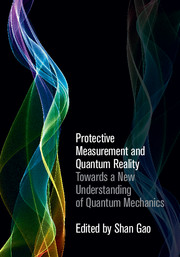Book contents
- Frontmatter
- Dedication
- Contents
- List of Contributors
- Preface
- Acknowledgements
- 1 Protective measurement: an introduction
- Part I Fundamentals and applications
- Part II Meanings and implications
- 7 Measurement and metaphysics
- 8 Protective measurement and the explanatory gambit
- 9 Realism and instrumentalism about the wave function: how should we choose?
- 10 Protective measurement and the PBR theorem
- 11 The roads not taken: empty waves, wave function collapse and protective measurement in quantum theory
- 12 Implications of protective measurement on de Broglie–Bohm trajectories
- 13 Entanglement, scaling, and the meaning of the wave function in protective measurement
- 14 Protective measurement and the nature of the wave function within the primitive ontology approach
- 15 Reality and meaning of the wave function
- Index
- References
13 - Entanglement, scaling, and the meaning of the wave function in protective measurement
from Part II - Meanings and implications
Published online by Cambridge University Press: 05 January 2015
- Frontmatter
- Dedication
- Contents
- List of Contributors
- Preface
- Acknowledgements
- 1 Protective measurement: an introduction
- Part I Fundamentals and applications
- Part II Meanings and implications
- 7 Measurement and metaphysics
- 8 Protective measurement and the explanatory gambit
- 9 Realism and instrumentalism about the wave function: how should we choose?
- 10 Protective measurement and the PBR theorem
- 11 The roads not taken: empty waves, wave function collapse and protective measurement in quantum theory
- 12 Implications of protective measurement on de Broglie–Bohm trajectories
- 13 Entanglement, scaling, and the meaning of the wave function in protective measurement
- 14 Protective measurement and the nature of the wave function within the primitive ontology approach
- 15 Reality and meaning of the wave function
- Index
- References
Summary
We examine the entanglement and state disturbance arising in a protective measurement and argue that these inescapable effects doom the claim that protective measurement establishes the reality of the wave function. An additional challenge to this claim results from the exponential number of protective measurements required to reconstruct multi-qubit states. We suggest that the failure of protective measurement to settle the question of the meaning of the wave function is entirely expected, for protective measurement is but an application of the standard quantum formalism, and none of the hard foundational questions can ever be settled in this way.
Introduction
From the start, the technical result of protective measurement has been suggested to have implications for the interpretation of quantum mechanics. Consider how Aharonov and Vaidman [2] chose to begin their original paper introducing the idea of protective measurement:
We show that it is possible to measure the Schrödinger wave of a single quantum system. This provides a strong argument for associating physical reality with the quantum state of a single system.…
Since then, the pioneers of protective measurement seem to have taken a more moderate stance. Vaidman [42], in a recent synopsis of protective measurement, concedes that
the protective measurement procedure is not a proof that we should adopt one interpretation instead of the other, but it is a good testbed which shows advantages and disadvantages of various interpretations.
Notwithstanding this more subtle perspective and a number of critical studies of the technical and foundational aspects of protective measurement, Gao [21] has maintained, if not amplified, the force of Aharonov and Vaidman's original argument:
An immediate implication is that the result of a protective measurement, namely the expectation value of the measured observable in the measured state, reflects the actual physical property of the measured system, as the system is not disturbed after this result has been obtained.
[…]
- Type
- Chapter
- Information
- Protective Measurement and Quantum RealityTowards a New Understanding of Quantum Mechanics, pp. 180 - 194Publisher: Cambridge University PressPrint publication year: 2015
References
- 2
- Cited by



